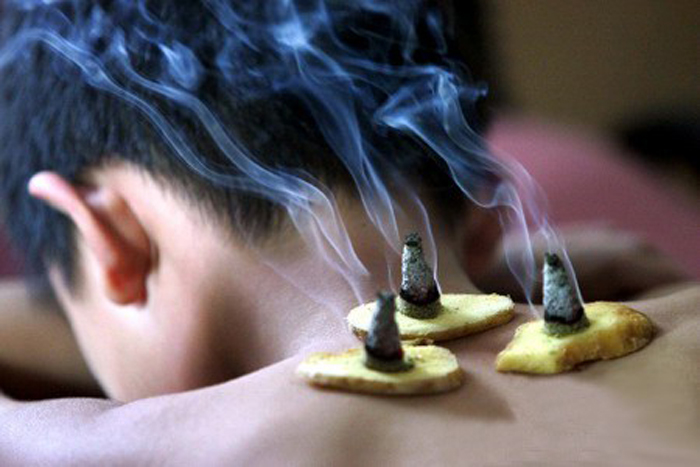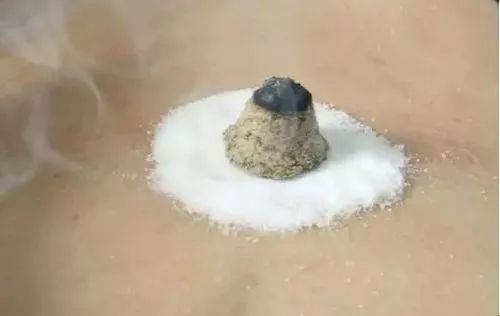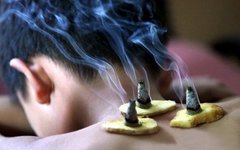
Moxibustion, also known as ai jiu (艾灸), is a method that uses mugwort (艾绒) as the main material to create moxa sticks or cones. When ignited, it is applied directly or indirectly to specific acupuncture points on the body, providing thermal stimulation to achieve disease prevention, treatment, and health maintenance.The materials for moxibustion vary, including moxa sticks, herbal moxibustion, electrical moxibustion, and other types. Historically, moxa has primarily been made from mugwort leaves (艾叶). Shennong Bencao Jing states: “Mugwort leaves are bitter, slightly warm, non-toxic, and are used to treat hundreds of diseases.” Bencao Gangmu records that mugwort, when used as a medicine, is warm in nature, bitter in taste, non-toxic, purely yang in nature, connects with the twelve meridians, and has effects such as warming yang, regulating qi and blood, and dispelling dampness and cold.
Effects and Indications
Moxibustion has the effects of warming the meridians and dispersing cold, promoting qi and unblocking collaterals, dispelling cold and dampness, reducing swelling and dissipating nodules, invigorating blood and dispersing stasis, lifting yang and rescuing from collapse, and preventing disease and maintaining health.
Moxibustion is primarily used for treating deficiency cold diseases and chronic conditions caused by the invasion of wind, cold, and dampness. It can also be used for disease prevention and health maintenance.
Common Moxibustion Methods
Based on the form of mugwort and the application methods of moxibustion, it can be broadly categorized into moxa stick moxibustion, moxa cone moxibustion, warm needle moxibustion, warm moxibustion devices, and herbal moxibustion. Below are several commonly used moxibustion therapies from the Pinghu Traditional Chinese Medicine Hospital.
1
Portable Moxibustion: Portable moxibustion is particularly suitable for warming the meridians, dispelling cold, relieving constipation, treating menstrual pain, and addressing conditions caused by wind and cold. It can also be used for health maintenance and beauty care in daily life. Its convenience allows for moxibustion to be performed anytime and anywhere, making it safe and easy to use.
2
Moxibustion Box: This is a type of warm moxibustion device where mugwort is made into sticks, ignited, and placed in a moxibustion box, which is then positioned on selected acupuncture points for treatment. It can harmonize qi and blood, warm the interior, and disperse cold. It is safe for general use and is particularly suitable for children, women, and those who are apprehensive about moxibustion.
3
Gourd Moxibustion: As the name suggests, this method uses a gourd for moxibustion. The gourd’s closed and accommodating nature allows for a broader coverage area compared to traditional moxibustion. Its unique structure enables the warmth from the moxa to circulate, providing a high level of comfort. The acupuncture points maintain a constant temperature, enhancing the warming effects of mugwort. It has the functions of warming yang, supporting the body’s defenses, and unblocking the meridians, effectively balancing yin and yang in the body to prevent and treat diseases. It is commonly used for various internal medicine and gynecological conditions, such as menstrual pain, postpartum back pain, children’s diarrhea, abdominal distension, and indigestion; it can also be used for physical conditioning, such as weakness in the lower back and knees, sensitivity to cold, cold extremities, low immunity, chronic fatigue, and sub-health conditions.
4
Du Mai Moxibustion: Also known as Long Snake Moxibustion or Fire Dragon Moxibustion, this method involves moxibustion along the Du Mai (督脉) on the back. The Du Mai governs the yang energy of the body and is referred to as the “sea of yang meridians.” Du Mai moxibustion has the effects of supporting the body’s defenses and warming yang, stimulating the body’s yang energy and promoting its generation. It is suitable for most deficiency cold and chronic diseases, such as rheumatoid arthritis, chronic lumbar muscle strain, cervical spondylosis, lumbar spondylosis, chronic rhinitis, chronic gastritis, chronic enteritis, diarrhea, dizziness, low immunity, menstrual irregularities, dysmenorrhea, and chronic pelvic inflammatory disease.
5
Direct Moxibustion: This is a type of moxa cone moxibustion, also known as ming jiu (明灸) or skin contact moxibustion. It involves placing a moxa cone directly on the skin at the acupuncture point.
Depending on the degree of skin irritation after moxibustion, it can be classified into scar moxibustion and non-scar moxibustion. If the skin is burned and suppurated, leaving a scar, it is called scar moxibustion. If the skin is not burned or scarred, it is called non-scar moxibustion.

Types of Moxibustion
1. Ginger Moxibustion
Ginger moxibustion:This method uses slices of fresh ginger placed on acupuncture points, followed by moxibustion. It has the effects of warming the stomach and stopping vomiting, as well as dispersing cold and alleviating pain. It is recorded in Yao Jiu Da Cheng by Yang Jizhou from the Ming Dynasty: “For moxibustion, use fresh ginger slices as thick as coins, place them on the tongue acupuncture point, and then perform moxibustion.” In Lei Jing Tu Yi by Zhang Jingyue, it is mentioned for treating hemorrhoids: “Simply use thin slices of fresh ginger, place them on the painful area, and perform moxibustion on the ginger for three times, and the yellow fluid will emerge and dissipate.” This method is convenient and easy to operate, with significant therapeutic effects.
2. Salt Moxibustion
Salt moxibustion: This method uses salt as a barrier for moxibustion, applied only at the navel area, hence also known as shen que jiu (神阙灸). Salt is cold and salty, entering the stomach, kidney, and large intestine meridians, with functions of inducing vomiting, clearing heat, cooling blood, and detoxifying. This method is used for warming yang, rescuing from collapse, and is suitable for acute abdominal pain, vomiting, diarrhea, cold extremities, gonorrhea, and collapse.

3. Grain Moxibustion
Grain moxibustion: This method involves rolling mugwort into the size of grains and placing them directly on the acupuncture points to burn. They are removed when the patient feels a burning sensation, with each point receiving 3-9 applications to stimulate the points for therapeutic purposes.
As the saying goes: “The sun in the sky, the mugwort on the ground.” The fire of mugwort is pure yang fire, which has the function of circulating through the twelve meridians. By burning the mugwort, the pure yang warmth penetrates through the skin at the acupuncture points, traveling through the meridians to the five organs and six bowels, warming the yang deficiency and dispelling internal and external cold.
Grain moxibustion has been widely used in folk medicine for over two thousand years. Before the invention of moxa sticks in the Qing Dynasty, grain moxibustion was a primary method. As a type of moxibustion, grain moxibustion and acupuncture together occupy two-thirds of the Huangdi Neijing, highlighting its significant position in traditional Chinese medicine.
Precautions
1. After moxibustion, symptoms such as skin redness and thirst may occur, which are generally normal. It is advisable to drink warm water and maintain the local skin temperature to prevent wind and cold exposure. After moxibustion, it is recommended to avoid drinking chrysanthemum tea or other cold beverages, as this may affect the efficacy of moxibustion.
2. If other sensations occur at the moxibustion site or distant from it, such as soreness, swelling, numbness, heat, heaviness, pain, or cold, or if severe symptoms like fever, dizziness, or irritability occur, appropriate rest is needed, and a small amount of warm water should be consumed. Consult a doctor in a timely manner.
3. Keep the moxibustion area clean. For scar moxibustion, it may be necessary to apply a dressing to protect the wound.
4. Ensure safety during moxibustion to prevent burns from the moxa fire, except for scar moxibustion. Also, take care to avoid damaging clothing, bedding, and other items.
5. If blisters appear at the moxibustion site, small ones can be left to absorb naturally. If larger blisters occur, they can be punctured with a sterilized needle to release the fluid, followed by disinfection. For scar moxibustion, during the suppuration period, avoid heavy physical labor for one month, do not scratch the scab, and keep the area clean to prevent infection.
6. Since moxibustion often involves fire, specific environmental, material, and technical operation requirements must be met. During moxibustion, attention should be paid to body position, accurate selection and localization of acupuncture points, assessment of moxibustion time and temperature, and the ability to manage reactions such as fainting. Therefore, it is recommended to perform moxibustion under the guidance of a medical institution or physician.
⊙Copyright Statement: The article is sourced from the internet, and the copyright belongs to the original author. If there is any infringement, please contact the public account for deletion. Thank you.


